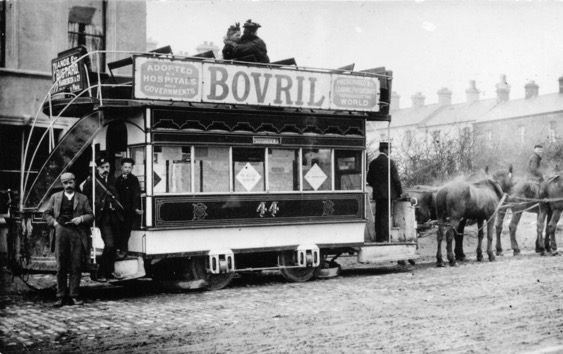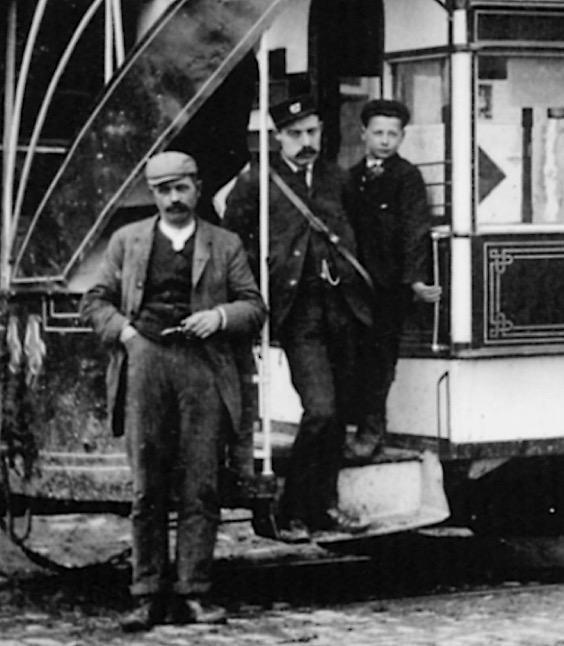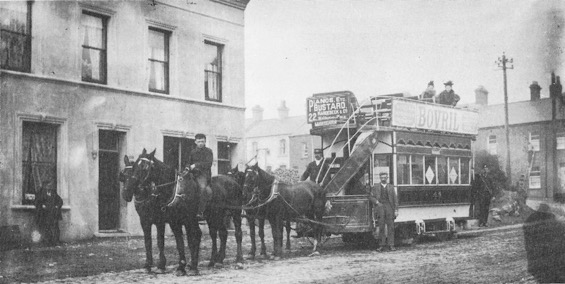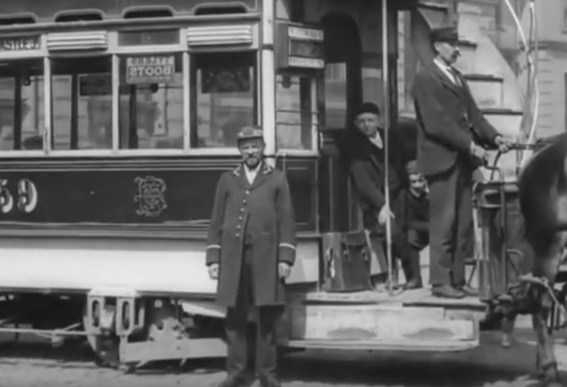Belfast Street Tramways
History
Belfast Street Tramways, which were operated for their entire existence by the Belfast Street Tramways Company, started out as a 5ft 3ins-gauge (Irish Standard Gauge) horse tramway on the 28th August 1872. In 1877, a decision was made to switch to the British Standard Gauge of 4ft 8½ins, with all new lines being built to this gauge, and existing lines, which amounted to around five miles at this time, being converted.
The BSTCo's monopoly came under threat in 1885, when the Sydenham District Tramways Company appeared on the scene with plans to build a line eastwards towards Belmont; the BSTCo however, soon reached agreement with the newcomer, and was contracted to build and operate the line, services commencing around the end of 1888. By this time, the company was well run, and despite having invested heavily in extensions, infrastructure and cars, was turning a very tidy profit, declaring dividends as high as 7%.
A further tramway company appeared in 1892 — the Belfast and Ligoniel Tramway Company — with plans to build a line northwestwards towards Ligoniel; once again, the BSTCo quickly reached agreement with the new company, building and operating the tramway on their behalf, the first service commencing on the 24th April 1893. In 1894, the BSTCo entered into yet another agreement, this time with the Belfast and County Down Railway, to operate a short line of 111yds from the BSTCo's tracks into the B&CDR's Queens Quay Station; unlike previous agreements however, the B&CDR built the line itself.
In 1896, the company obtained powers to electrify the system, but could not reach agreement with Belfast Corporation, which had the right to purchase the tramway at specific time intervals. The company was quite naturally reluctant to make the heavy investment necessary, in the absence of any guarantees from the corporation. Whilst the company opened several extensions in 1898, the failure to secure agreement on electrification must have weighed heavily upon it, especially in the following year, when the corporation sought powers to build its own lines, which were effectively extensions of the BSTCo's. These were completed towards the end of 1900, and though they were leased to the BSTCo, it must have been clear to all, that the corporation intended to bring the tramways under municipal control. With this in mind, the company approached the corporation in 1902 offering to sell them the undertaking, but the corporation's valuation fell short of the company's, so no agreement could be reached.
Under the agreements with the SDTCo and the B & LTCo, the BSTCo had the right to purchase these tramways at the end of the respective leases, which it did around August 1902.
The corporation's attitude to the BSTCo hardened, and in 1904, it successfully sought powers to compulsorily purchase the undertaking. The corporation took control on the 1st January 1905, with the BSTCo receiving compensation following arbitration, which was around 10% less than the corporation had offered three years before.
The last horse-tram service ran on the 4th December 1905, under the management of Belfast Corporation Tramways.
At its largest extent, the BSTCo's horse tramway system totalled 25 miles, comprising lines: eastwards to Belmont and Knock; southeastwards to Cregagh; southwards to Ravenhill, Galwally Park and Malone; southwestwards to Balmoral and Falls Park; westwards to Springfields and Shankhill; northwestwards to Ligoniel; and northwards to Chichester and along Shore Rd.
Uniforms
The Belfast Street Tramways Company branded its sizeable operation as 'Belfast City Tramways', and whilst the photographic record is relatively rich, it is unfortunately difficult to date with any precision, so what follows is far from certain. In later years, both conductors and drivers wore single-breasted jackets with lapels; the jackets however, appear to have been entirely unmarked, i.e., devoid of badges, so were probably self purchased. Caps were in a kepi-style and bore an employee number in individual metal numerals; it is unclear whether these were brass or nickel. Tramcar crews also wore greatcoats (with lapels), which at various times were either single-breasted or double-breasted; like the jackets, they appear to have been unmarked, suggesting that they too were self purchased.
A single shot of what would appear to be an inspector has survived in a film taken by Mitchell and Kenyon in 1901. The individual depicted is wearing a long, frock-style coat, with a single row of six buttons and lapels; the coat collars and cuffs are embellished with material of a lighter colour. Headgear takes the form of a kepi-style cap with an elaborate hat band, upon which is mounted a large cap badge of unknown pattern; it is unclear whether this was embroidered or metallic.
Further reading
For a history of the BSTCo, see: 'The Belfast Street Tramways' by Alan T Newham; Tramway Review 78 (p163-178), 79 (p195–207) and 80 (p245-252); Light Railway Transport League (1974).
Images
Horse tram drivers and conductors
Belfast Street Tramways Company Horsecar No 44 stands on an extremely filthy road somewhere on the Woodvale Rd route, probably the terminus — photo undated, but possibly taken before the corporation take-over of 1905. Photo courtesy of the Tramways and Light Railway Society, with thanks to David Voice.
An enlargement of the above photograph showing the conductor, who is wearing a single-breasted jacket (possibly with metallic buttons), but otherwise devoid of insignia. His kepi-style cap bears an employee number.
The same horsecar (No 44) at the same location as the previous photo — undated, but probably taken in the 1890s. Both the conductor and driver are wearing the usual single-breasted jackets and kepi-style caps. Photo courtesy of the Tramways and Light Railway Society, with thanks to David Voice.
Senior staff
A uniformed individual, very probably a BSTCo inspector, stands in front of Horsecar 59 in 1901. Photo taken from a Mitchell and Kenyon film, courtesy of the British Film Institute.